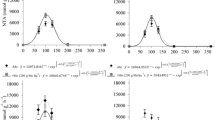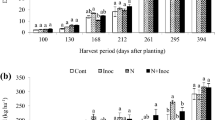Abstract
The association between sorghum and N2-fixing bacteria has been assessed only under limited conditions. We investigated biological nitrogen fixation (BNF) in situ in fifteen sorghum genotypes with dry or succulent culm types under five edaphoclimatic conditions. One randomized block experiment was established in each of five locations, from the humid to the semiarid regions of Pernambuco state, Brazil. BNF was estimated using the 15N natural abundance method by comparing the average δ15N value of each sorghum genotype with those of the reference species. High levels of productivity, up to 22 Mg shoot biomass ha−1 in the 3-month cycle, were obtained where rainfall was high, and up to 5 Mg ha−1 was obtained under low rainfall. The nitrogen contents showed a similar pattern as biomass production, and the genotypes with the highest productivity accumulated from 200 to 300 kg N ha−1. BNF ranged from 55 to 78% of plant N in one location and from 36 to 56% in another location, but BNF did not occur in the other three locations. Although the factors that blocked effective symbiosis were not determined, symbiosis was not influenced by P or K availability. The proportion of N2 fixation was similar in the grain-producing, dry culm genotypes and in the sugar-rich, succulent culm genotypes. The sorghum genotypes fixed N2, reaching up to 218 kg ha−1 N, without inoculation with diazotrophs. Therefore, sorghum has a high potential to fix atmospheric N2, but the factors that block N2 fixation must be identified for crop management planning.
Similar content being viewed by others
References
Albrizio R, Steduto P (2005) Resource use efficiency of field-grown sunflower, sorghum, wheat and chickpea I. Radiation use efficiency. Agric Forest Meteorol 130:254–268. https://doi.org/10.1016/j.agrformet.2005.03.009
Alves GC, Videira SS, Urquiaga S, Reis VM (2015) Differential plant growth promotion and nitrogen fixation in two genotypes of maize by several Herbaspirillum inoculants. Plant Soil 387:307–321. https://doi.org/10.1007/s11104-014-2295-2
Amarger N, Mariotti A, Mariotti F, Durr JC, Bourguignon C, Lagacherie B (1979) Estimate of symbiotically fixed nitrogen in field grown soybeans using variations in 15N natural abundance. Plant Soil 52:269–280
Ananda N, Vadlani PV, Prasad PVV (2011) Evaluation of drought and heat stressed grain sorghum (Sorghum bicolor) for ethanol production. Ind Crop Prod 33:779–782. https://doi.org/10.1016/j.indcrop.2011.01.007
Antunes GR, Santana SRA, Escobar IEC, Brasil MS, Araújo GGL, Voltolini TV, Fernandes-Júnior PI (2019) Associative diazotrophic bacteria from forage grasses in the Brazilian semiarid region are effective plant growth promoters. Crop Pasture Sci 70:899–907. https://doi.org/10.1071/CP19076
Baptista RB, Morais RF, Leite JM, Schultz N, Alves BJR, Boddey M, Urquiaga S (2014) Variations in the 15N natural abundance of plant-available N with soil depth: their influence on estimates of contributions of biological N2 fixation to sugar cane. Appl Soil Ecol 73:124–129. https://doi.org/10.1016/j.apsoil.2013.08.008
Biggs IM, Stewart GR, Wilson JR, Critchley C (2002) 15N natural abundance studies in Australian commercial sugarcane. Plant Soil 238:21–30
Carvalho EX, Menezes RSC, Freitas ADS, Sampaio EVSB, Simões Neto DE, Tabosa JN, Primo DC, Queiroz RO (2017) The 15N natural abundance technique to assess the potential of biological nitrogen fixation (BNF) in some important C4 grasses. Aust J Crop Sci 11:1559–1564. https://doi.org/10.21475/ajcs.17.11.12.pne729
Coelho MRR, Marriel IE, Jenkins SN, Lanyon CV, Seldin L, O’Donnell AG (2009) Molecular detection and quantification of nifH gene sequences in the rhizosphere of sorghum (Sorghum bicolor) sown with two levels of nitrogen fertilizer. Appl Soil Ecol 42:48–53. https://doi.org/10.1016/j.apsoil.2009.01.010
Davila-Gomez FJ, Chuck-Hernandez C, Perez-Carrillo E, Rooney WL, Serna-Saldivar SO (2011) Evaluation of bioethanol production from five different varieties of sweet and forage sorghums (Sorghum bicolor (L) Moench). Ind Crop Prod 33:611–616. https://doi.org/10.1016/j.indcrop.2010.12.022
Embrapa—Empresa Brasileira de Pesquisa Agropecuária (2009) Manual de análises químicas de solos, plantas e fertilizantes, 2nd ed. In: Embrapa Solos, Embrapa Informática Agropecuária, Brasília
FAO—Food and Agriculture Organization of the United Nations (2010) FAOSTAT. http://www.faostat.org/site/567/. Accessed on 18 March 2015
Fernandes G, Braga TG, Fischer J, Parrella RAC, Resende MM, Cardoso VL (2014) Evaluation of potential ethanol production and nutrients for four varieties of sweet sorghum during maturation. Renew Energy 71:518–524. https://doi.org/10.1016/j.renene.2014.05.033
Ferreira DF (2008) SISVAR: um programa para análises e ensino da estatística. Rev Symp 6:36–41
Ferreira Neto RA, Freitas ADS, Giongo V, Camargo PB, Menezes RSC, Sampaio EVSB (2017) Nitrogen fixation of Poaceae and Leguminoseae in a green manure experiment in the Brazilian semiarid region. Aust J Crop Sci 11:1559–1564. https://doi.org/10.21475/ajcs.17.11.11.pne726
Guigou M, Lareo C, Pérez LV (2011) Bioethanol production from sweet sorghum: evaluation of post-harvest treatments on sugar extraction and fermentation. Biomass Bioenerg 35:3058–3062. https://doi.org/10.1016/j.biombioe.2011.04.028
Hara S, Morikawa T, Wasai S, Kasahara Y, Koshiba T, Yamazaki K, Fujiwara T, Tokunaga T, Minamisawa K (2019) Identification of nitrogen-fixing Bradyrhizobium associated with roots of field-grown sorghum by metagenome and proteome analyses. Front Microbiol. https://doi.org/10.3389/fmicb.2019.00407
Junk G, Svec HV (1958) The absolute abundance of the nitrogen isotopes in the atmosphere and compressed gas from various sources. Geochim Cosmochim Acta 14:234–243
Kurdaly K (2009) Growth and nitrogen fixation in Dhaincha/Sorghum and Dhaincha/sunflower intercropping systems using 15Nitrogen and 13Carbon natural abundances techniques. Commun Soil Sci Plant Anal 40:2995–3014. https://doi.org/10.1080/00103620903261577
Luna MF, Galar ML, Aprea J, Molinari ML, Boiardi JL (2010) Colonization of sorghum and wheat by seed inoculation with Gluconacetobacter diazotrophicus. Biotechnol Lett 32:1071–1076. https://doi.org/10.1007/s10529-010-0256-2
Mariotti A (1983) Atmospheric nitrogen is a reliable standard for natural δ15N abundance measurements. Nature 303:685–687
Martinez-Feria RA, Castellano MJ, Dietzel RN, Helmers MJ, Liebman M, Huber I, Archontoulis SV (2018) Linking crop- and soil-based approaches to evaluate system nitrogen-use efficiency and tradeoffs. Agric Ecosyst Environ 256:131–143. https://doi.org/10.1016/j.agee.2018.01.002
Mathur S, Umakanth AV, Tonapi VA (2017) Sweet sorghum as biofuel feedstock: recent advances and available resources. Biotechnol Biofuels 10:146. https://doi.org/10.1186/s13068-017-0834-9
Monteiro RA, Balsanelli E, Wassem R, Brusamarello-Santos LCC, Schmidt MA, Tadra-Sfeir MT, Pankievicz VCS, Cruz LM, Chubatsu LS, Pedrosa FO, Souza EM (2012) Herbaspirillum-plant interactions: microscopical, histological and molecular aspects. Plant Soil 356:175–196. https://doi.org/10.1007/s11104-012-1125-7
Morais RF, Quesada DM, Reis VM (2012) Contribution of biological nitrogen fixation to Elephant grass (Pennisetum purpureum Schum.). Plant Soil 356:23–34. https://doi.org/10.1007/s11104-011-0944-2
O’Hara GW (2001) Nutritional constraints on root nodule bacteria affecting symbiotic nitrogen fixation: a review. Aust J Exp Agric 41:417–433
Puri A, Padda KP, Chanway CP (2017) Nitrogen-fixation by endophytic bacteria in agricultural crops: recent advances. In: Amanullah K, Fahad S (eds) Nitrogen in agriculture—updates. Intech, Rijeka, pp 73–94. https://doi.org/10.5772/intechopen.71988
Roncato-Maccari LDB, Ramos HJO, Pedrosa FO, Alquini Y, Chubatsu LS, Yates MG, Rigo LU, Steffens MBR, Souza EM (2003) Endophytic Herbaspirillum seropedicae expresses nif genes in gramineous plants. FEMS Microbiol Ecol 45:39–47. https://doi.org/10.1016/S0168-6496(03)00108-9
Sampaio EVSB, Salcedo IH, Bettany J (1984) Dinâmica de nutrientes em cana-de-açúcar. I. Eficiência na utilização de uréia (-15N) em aplicação única ou parcelada. Pesq Agropec Bras 19:943–949
Sampaio EVSB, Tiessen H, Antonino ACD, Salcedo IH (2004) Residual N and P fertilizer effect and fertilizer recovery on intercropped and sole-cropped corn and beans in semiarid northeast Brazil. Nutr Cyc Agroecosys 70:1–11. https://doi.org/10.1023/B:FRES.0000049356.83427.93
Santos CLR, Alves GC, Macedo AVM, Fiori FG, Pereira W, Urquiaga S, Reis VM (2017) Contribution of a mixed inoculant containing strains of Burkholderia spp. and Herbaspirillum ssp. to the growth of three sorghum genotypes under increased nitrogen fertilization levels. Appl Soil Ecol 113:96–106. https://doi.org/10.1016/j.apsoil.2017.02.008
Shearer G, Kohl DH (1986) N2-fixation in field settings: estimations based on natural 15N abundance. Aust J Plant Physiol 13:699–756
Shearer G, Kohl DH (1989) Natural 15N abundance as a method of estimating the contribution of biologically fixed nitrogen to N2-fixing systems: potential for non-legumes. In: Skinner FA, Boddey RM, Fendrik I (eds) Nitrogen fixation with non-legumes. Kluwer Academic Publishers, Dordrecht, pp 289–299
Silva AF, Freitas ADS, Costa TL, Fernandes-Júnior PI, Martins LMV, Santos CERS, Menezes KAS, Sampaio EVSB (2017) Biological nitrogen fixation in tropical dry forests with different legume diversity and abundance. Nutr Cycl Agroecosyst 107:321–334. https://doi.org/10.1007/s10705-017-9834-1
Silva JF, Silva TR, Escobar IEC, Fraiz ACR, Santos JWM, Nascimento TR, Santos JMR, Peters SJW, Melo RF, Signor D, Fernandes-Júnior PI (2018) Screening of plant growth promotion ability among bacteria isolated from field-grown sorghum under different managements in Brazilian drylands. World J Microbiol Biotechnol 34:186. https://doi.org/10.1007/s11274-018-2568-7
Steduto P, Albrizio R (2005) Resource use efficiency of field-grown sunflower, sorghum, wheat and chickpea II. Water use efficiency and comparison with radiation use efficiency. Agric Forest Meteorol 130:269–281. https://doi.org/10.1016/j.agrformet.2005.04.003
Stein T, Hayen-Schneg N, Fendrik I (1997) Contribution of BNF by Azoarcus sp. BH72 in Sorghum vulgare. Soil Biol Biochem 29:969–971
Thomas RL, Sheard RW, Moyer JR (1967) Comparison of conventional and automated procedures for nitrogen, phosphorus, and potassium analysis of plant material using a single digestion. Agron J 59:240–243
Tiessen H, Sampaio EVSB, Salcedo IH (2001) Organic matter turnover and management in low input agriculture of NE Brazil. Nutr Cycl Agroecosyst 61:99–103. https://doi.org/10.1023/A:1013384730492
Tuinstra MR (2008) Food-grade sorghum varieties and production considerations: a review. J Plant Interact 3:69–72. https://doi.org/10.1080/17429140701722770
Urquiaga S, Xavier RP, Morais RF, Batista RB, Schultz N, Leite JM, Sá JM, Barbosa KP, Resende AS, Alves BJR, Boddey RM (2012) Evidence from field nitrogen balance and 15N natural abundance data for the contribution of biological N2 fixation to Brazilian sugarcane varieties. Plant Soil 356:5–21. https://doi.org/10.1007/s11104-011-1016-3
Vasilakoglou I, Dhima K, Karagianiannidis N (2011) Sweet sorghum productivity for biofuels under increased soil salinity and reduced irrigation. Field Crop Res 120:38–46. https://doi.org/10.1016/j.fcr.2010.08.011
Weisany W, Raei Y, Allahverdipoor KH (2013) Role of some of mineral nutrients in biological nitrogen fixation. Bull Environ Pharmacol Life Sci 2:77–84
Yang J, Udvardi M (2018) Senescence and nitrogen use efficiency in perennial grasses for forage and biofuel production. J Exp Bot 69:855–865. https://doi.org/10.1093/jxb/erx241
Yoon V, Tian G, Vessey JK, McFie SM, Dangi OM, Kumer AK, Tian L (2016) Colonization efficiency of different sorghum genotypes by Gluconacetobacter diazotrophicus. Plant Soil 398:243–256. https://doi.org/10.1007/s11104-015-2653-8
Acknowledgements
The authors thank the Brazilian Council for Scientific and Technological Development (CNPq; Projeto Universal 2012, Grant Number 472997/2012-2), the Projeto “Pesquisas integradas para a garantia da sustentabilidade hídrica, alimentar e energética no Bioma Caatinga” (PEGASUS 19-2017-Nexus, Grant Number 441305/2017-2), the Fundação de Amparo à Ciência e Tecnologia de Pernambuco (FACEPE; Grant Number APQ-0199-5.01/15) and the Brazilian Agricultural Research Corporation (Embrapa Grant Number 20.18.03.066.00.00) for financial support. The second and last two authors are research fellows of CNPq.
Author information
Authors and Affiliations
Corresponding authors
Additional information
Publisher's Note
Springer Nature remains neutral with regard to jurisdictional claims in published maps and institutional affiliations.
Electronic supplementary material
Below is the link to the electronic supplementary material.
Rights and permissions
About this article
Cite this article
Barros, B.G.F., Freitas, A.D.S., Tabosa, J.N. et al. Biological nitrogen fixation in field-grown sorghum under different edaphoclimatic conditions is confirmed by N isotopic signatures. Nutr Cycl Agroecosyst 117, 93–101 (2020). https://doi.org/10.1007/s10705-020-10051-3
Received:
Accepted:
Published:
Issue Date:
DOI: https://doi.org/10.1007/s10705-020-10051-3




